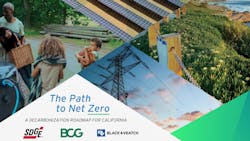SDG&E Releases Decarbonization Roadmap With First Utility Industry Standard Reliability Analysis
One of the biggest challenges facing the San Diego region and California is how to decarbonize key economic sectors over the next two decades, while also helping to ensure electric reliability, affordability and equity. A study released today by San Diego Gas & Electric offers recommendations designed to help meet the monumental challenge of achieving California’s goal of carbon neutrality by 2045 – removing as much carbon emissions from the atmosphere as the state produces.
While other studies have been published on how to decarbonize California’s economy through electrification of sectors such as transportation and buildings, SDG&E’s study, “The Path to Net Zero: A Decarbonization Roadmap for California,” also incorporates for the first time the utility industry standard for reliability using industry-specific planning tools to chart what we believe to be an achievable approach. The industry standard considers an electric system to be reliable if it experiences only one power outage every ten years due to the probability of energy demand exceeding supply.
Conducted with technical support from the Boston Consulting Group, Black & Veatch and UC San Diego Professor David G. Victor, the study concluded that a diversified decarbonization approach is necessary: a combination of clean electricity, clean fuels (such as renewable natural gas and clean hydrogen) and carbon removal.
“Accelerated electrification of transportation and other sectors is essential to California and our region’s sustainability. It is also incredibly important that California takes electric reliability into consideration and doesn’t leave anyone behind when developing a decarbonization roadmap,” said SDG&E CEO Caroline Winn. “Given the scale of the transformation required to achieve California’s ambitious goals, collaboration across many sectors will be critical.
SDG&E alone cannot implement the decarbonization Roadmap, but we are committed to helping enable an equitable, safe, reliable and affordable energy transition, and that includes investments in electric vehicle charging infrastructure, grid modernization and emerging innovations like long-duration, hydrogen-based energy storage.”
Victor, co-director of UCSD’s Deep Decarbonization Initiative, served as the study’s advisor and echoed one of its key findings. “While the exact combination of technologies and investments needed to get to net zero is unknown at this time, what is certain today is that a flexible and diversified approach to decarbonization is both prudent and necessary to help ensure we are eliminating carbon emissions while also safeguarding grid reliability,” he said. Victor also noted that decarbonization, done well, could actually lower the fraction of the California economy that is spent on energy services while also providing leadership on global strategies to cut emissions.
“The state’s clean energy industry is ready to lead the way on decarbonization and deliver solutions that benefit our environment, local communities and the economy,” said Jason Anderson, president and CEO of Cleantech San Diego. “SDG&E’s analysis helps shine a light on the importance of policy collaboration and the need to rapidly scale a broad set of innovative energy technologies to reach California’s climate goals.”
“As an advocate for a just and equitable energy transition, I believe we all need to work together to accelerate the pace of decarbonization and bring everyone along,” said County Chair Nathan Fletcher. “We need to provide support for low-income and working households while the region moves towards adoption of clean technologies, such as electric vehicles and electric appliances.”
Takeaways from the Study
- California is estimated to need to decarbonize at 4.5 times the pace over the past decade to reach its carbon neutrality goal and mitigate the negative impacts of climate change.
- Electric generation capacity is estimated to need to increase to about four times the capacity that existed in 2020, in order to support transportation and building electrification. Between 2020 and 2045, electric consumption is expected to increase by 96%.
- To keep electric service reliable, California will need to complement its growing portfolio of intermittent solar and wind generation with a mix of clean, firm and flexible resources that can be dispatched at any time to meet needs. Installing 40 GW of new battery storage, as well as 20 GW of dispatchable generation from 100% clean hydrogen combustion by 2045 is projected as necessary to meet this goal. According to the California Independent System Operator, the statewide grid has interconnected about 2,600 MW of energy storage as of January 2022, but no electric generation from 100% clean hydrogen combustion.
- It is estimated that by 2045, there will be demand for 6.5 million metric tons of clean hydrogen across the economy, 80% of which is projected to be used to enhance the reliability of the electric supply.
- The implementation of the Roadmap requires regulatory and political support from four fronts to: 1) prioritize electric sector reliability; 2) maintain affordability and enhance equity; 3) incentivize innovation and adaptability; 4) and enable the deployment of decarbonization infrastructure.
- The implementation of the Roadmap requires regulatory and political support from four fronts to: 1) prioritize electric sector reliability; 2) maintain affordability and enhance equity; 3) incentivize innovation and adaptability; 4) and enable the deployment of decarbonization infrastructure.
- To help accelerate the energy transition, SDG&E will share this study widely with key stakeholders to stimulate conversations and cross-sector collaboration.
About the Author
T&D World Staff
Content Team
Nikki Chandler
Group Editorial Director, Energy
[email protected]
Jeff Postelwait
Managing Editor
[email protected]
Christina Marsh
Senior Editor
[email protected]
Ryan Baker
Associate Editor
[email protected]
Amy Fischbach
Electric Utility Operations
[email protected]
Rich Maxwell
Community Editor
[email protected]
Gene Wolf
Technical Editor
[email protected]
